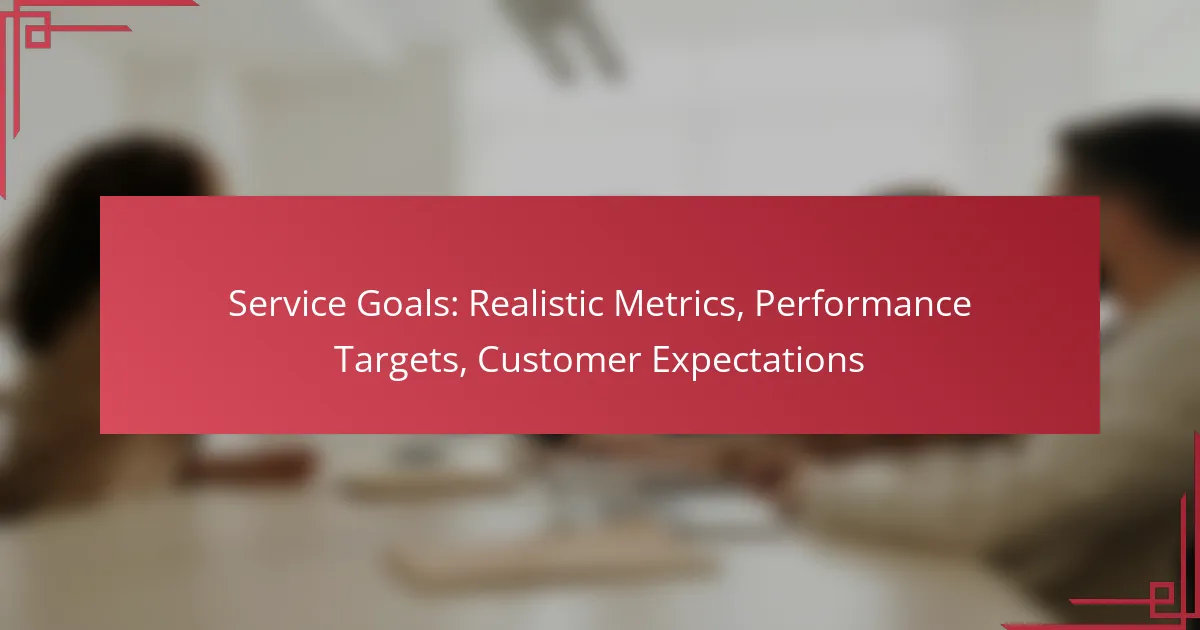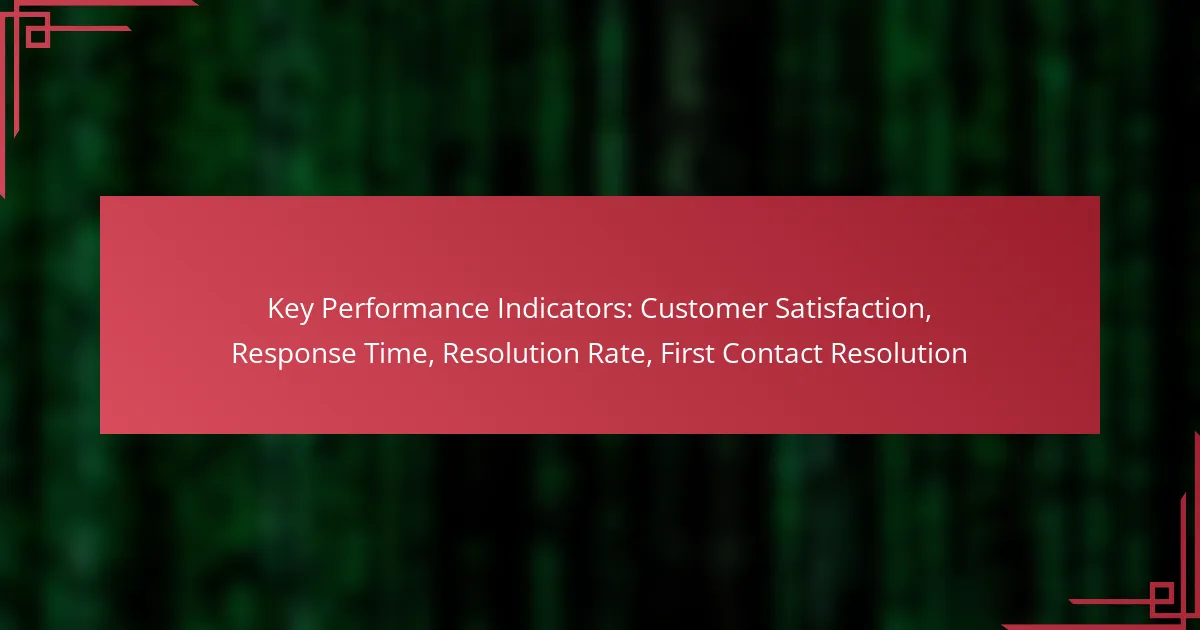Establishing realistic service goals is essential for businesses aiming to deliver consistent quality and meet customer needs effectively. By setting specific, measurable, and achievable performance targets, companies can enhance customer satisfaction while ensuring their objectives align with operational capabilities. Key metrics such as customer satisfaction scores and net promoter scores provide valuable insights into service performance and help maintain high standards of service delivery.

What are realistic service goals for businesses in the UK?
Realistic service goals for businesses in the UK focus on delivering consistent quality while meeting customer needs. These goals should be specific, measurable, and achievable to ensure that businesses can track their performance and improve customer satisfaction effectively.
Specific performance metrics
Specific performance metrics help businesses evaluate their service quality. Common metrics include response time, resolution time, and customer satisfaction scores. For example, aiming for a response time of under 30 minutes for customer inquiries can set a clear standard for service delivery.
Additionally, tracking Net Promoter Score (NPS) can provide insights into customer loyalty and overall satisfaction. Businesses should regularly review these metrics to identify areas for improvement and ensure they align with customer expectations.
Measurable targets
Measurable targets provide clear benchmarks for performance assessment. For instance, a target of resolving 80% of customer issues on the first contact can drive efficiency and enhance customer experience. Setting quarterly goals can help teams stay focused and motivated.
It’s essential to ensure that these targets are realistic and based on historical data. Regularly revisiting and adjusting targets based on performance trends can help maintain relevance and challenge teams appropriately.
Achievable customer expectations
Achievable customer expectations are crucial for maintaining satisfaction and loyalty. Businesses should communicate clearly about what customers can expect regarding service timelines and quality. For example, informing customers that they will receive a follow-up within 24 hours sets a practical expectation.
Understanding customer needs through surveys or feedback can help businesses align their service goals with what customers truly value. Avoid overpromising, as this can lead to disappointment and damage trust.

How to set performance targets effectively?
Setting performance targets effectively involves defining clear, measurable goals that align with your service objectives. Focus on creating targets that are realistic yet challenging, ensuring they meet customer expectations while being achievable for your team.
SMART criteria application
Applying the SMART criteria—Specific, Measurable, Achievable, Relevant, and Time-bound—ensures your performance targets are well-defined. For instance, instead of aiming to “improve customer service,” set a target like “reduce average response time to customer inquiries to under 2 hours within the next quarter.” This clarity helps teams understand what is expected and how success will be measured.
When using SMART criteria, consider the resources available and the current capabilities of your team. Targets should push for improvement but remain attainable to maintain motivation and avoid burnout.
Benchmarking against industry standards
Benchmarking involves comparing your performance targets to industry standards to ensure competitiveness. Researching metrics such as average resolution times or customer satisfaction scores in your sector can provide a reference point for setting your own targets.
For example, if the industry standard for customer satisfaction is around 80%, aim for a target that is slightly above this benchmark, like 82% or 85%. This approach not only helps in setting realistic goals but also encourages continuous improvement by striving to exceed industry norms.

What metrics should be tracked for service performance?
Key metrics for tracking service performance include customer satisfaction scores, net promoter scores (NPS), and service level agreements (SLAs). These metrics provide insights into how well services meet customer expectations and operational targets.
Customer satisfaction scores
Customer satisfaction scores (CSAT) measure how satisfied customers are with a service. Typically gathered through surveys, these scores can range from 1 to 5 or 1 to 10, with higher numbers indicating greater satisfaction. Regularly tracking CSAT helps identify areas for improvement and gauge customer loyalty.
To effectively use CSAT, consider implementing post-service surveys or feedback forms. Aim for a response rate of at least 20% to ensure a representative sample. A common target is to maintain a CSAT score above 80% to reflect strong customer approval.
Net promoter score (NPS)
The net promoter score (NPS) assesses customer loyalty by asking how likely customers are to recommend your service to others. Responses are typically scored from 0 to 10, with scores categorized into promoters, passives, and detractors. A higher NPS indicates a more loyal customer base.
To calculate NPS, subtract the percentage of detractors from the percentage of promoters. A good NPS is often considered to be above 50, while anything above 70 is exceptional. Regularly measuring NPS can help track changes in customer sentiment over time.
Service level agreements (SLAs)
Service level agreements (SLAs) define the expected level of service between a provider and a customer. These agreements typically include metrics such as response times, resolution times, and availability percentages. Clear SLAs set customer expectations and provide benchmarks for performance evaluation.
When establishing SLAs, consider industry standards and customer needs. For example, a common SLA for response time might be within 24 hours for non-urgent requests. Regularly review and adjust SLAs based on performance data and customer feedback to ensure they remain relevant and achievable.

How to align customer expectations with service goals?
Aligning customer expectations with service goals involves clear communication and consistent feedback. By establishing transparent dialogue and regularly assessing customer satisfaction, businesses can ensure that their service objectives meet client needs effectively.
Clear communication strategies
Effective communication is crucial for aligning customer expectations with service goals. Use straightforward language to explain service offerings, timelines, and potential outcomes. Regular updates through emails or newsletters can keep customers informed and engaged.
Consider implementing a customer portal where clients can access real-time information about their service status. This transparency builds trust and helps manage expectations by providing insights into what customers can anticipate.
Regular feedback mechanisms
Regular feedback is essential for understanding customer perceptions and adjusting service goals accordingly. Utilize surveys, polls, or direct interviews to gather insights about customer experiences and satisfaction levels. Aim for a response rate of around 20-30% to ensure meaningful data.
Incorporate feedback loops into your service delivery process, allowing customers to voice their opinions at various stages. This practice not only helps in refining services but also demonstrates to customers that their input is valued, fostering loyalty and satisfaction.

What are common pitfalls in setting service goals?
Common pitfalls in setting service goals include unrealistic expectations and a lack of stakeholder involvement. These issues can lead to misaligned objectives, decreased morale, and ultimately, customer dissatisfaction.
Unrealistic expectations
Unrealistic expectations occur when service goals are set too high or are not achievable within the given resources. For example, aiming for a 100% customer satisfaction rate may not be feasible, as it ignores the natural variability in customer preferences and experiences.
To avoid this pitfall, it’s essential to set measurable and attainable goals based on historical data and industry benchmarks. Consider using the SMART criteria—Specific, Measurable, Achievable, Relevant, and Time-bound—to guide goal-setting.
Lack of stakeholder involvement
A lack of stakeholder involvement can lead to goals that do not reflect the needs or capabilities of the team. When key players, such as customer service representatives or management, are not consulted, the resulting objectives may be disconnected from operational realities.
Engaging stakeholders in the goal-setting process fosters ownership and accountability. Regular meetings and feedback sessions can help ensure that everyone is aligned and that the goals set are realistic and relevant to the team’s capabilities.

How to evaluate the success of service goals?
Evaluating the success of service goals involves measuring performance against established metrics, assessing customer satisfaction, and analyzing feedback. This process helps organizations determine whether they are meeting their objectives and fulfilling customer expectations.
Performance reviews
Performance reviews are essential for assessing how well service goals are being met. They typically involve regular evaluations of employee performance, focusing on key performance indicators (KPIs) such as response times, resolution rates, and service quality. Establishing clear benchmarks allows for effective comparisons over time.
Consider implementing a structured review process that includes self-assessments, peer reviews, and manager evaluations. This multi-faceted approach can provide a comprehensive view of performance and highlight areas for improvement. Aim for quarterly reviews to ensure timely feedback and adjustments.
Customer feedback analysis
Customer feedback analysis is critical for understanding how well service goals align with customer expectations. Collecting feedback through surveys, interviews, and direct communication can provide insights into customer satisfaction and areas needing attention. Look for trends in feedback to identify common issues or strengths.
Utilize tools like Net Promoter Score (NPS) or Customer Satisfaction Score (CSAT) to quantify feedback. Regularly review this data and compare it against service goals to gauge success. Aim for a response rate of at least 20-30% on surveys to ensure the data is representative of your customer base.

What emerging trends affect service goals in the UK?
Emerging trends in the UK significantly influence service goals by shifting customer expectations and operational standards. Companies must adapt to these changes to remain competitive and meet evolving demands.
Increased focus on sustainability
Many UK consumers are prioritizing sustainability in their purchasing decisions, prompting businesses to set service goals that align with eco-friendly practices. This includes reducing waste, sourcing materials responsibly, and minimizing carbon footprints.
To effectively integrate sustainability into service goals, companies can adopt practices such as using biodegradable packaging or implementing energy-efficient processes. A clear commitment to sustainability can enhance brand loyalty and attract environmentally conscious customers.
Technological advancements
Technological advancements are reshaping service delivery, with automation and artificial intelligence becoming increasingly prevalent. Businesses are setting performance targets that leverage these technologies to improve efficiency and customer engagement.
For example, chatbots can handle customer inquiries 24/7, reducing response times and enhancing customer satisfaction. Companies should evaluate which technologies can streamline their operations while ensuring they meet customer expectations for personalized service.
Personalization of customer experiences
Personalization is a key trend affecting service goals, as customers now expect tailored experiences. Businesses must establish metrics that measure how well they meet individual customer needs and preferences.
Utilizing customer data to create personalized marketing campaigns or customized service offerings can significantly enhance customer satisfaction. Companies should regularly assess their performance against these personalization goals to ensure they are meeting customer expectations effectively.
Shift towards remote service delivery
The shift towards remote service delivery has accelerated, particularly in response to recent global events. Service goals now often include metrics for virtual engagement and remote support effectiveness.
Businesses should focus on ensuring that their remote service channels are as effective as in-person interactions. This may involve training staff in virtual communication skills and investing in technology that facilitates seamless remote interactions.


